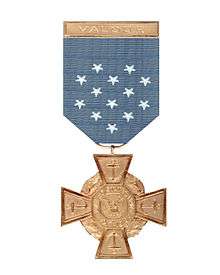Tiffany & Co.
Tiffany & Co. (colloquially known as Tiffany's)[4] is an American luxury jewelry and specialty retailer headquartered in New York City.[5] It sells jewelry, sterling silver, china, crystal, stationery, fragrances, water bottles, watches, personal accessories, and leather goods.[6] Tiffany is known for its luxury goods, particularly its diamond and sterling silver jewelry.[7][8][9][10] It markets itself as an arbiter of taste and style.[11] These goods are sold at Tiffany stores, and through direct-mail and corporate merchandising.
Formerly | Tiffany, Young and Ellis (1837–1853) |
|---|---|
| Public | |
| Traded as | NYSE: TIF S&P 500 Component |
| ISIN | US8865471085 |
| Industry | Retail |
| Founded | September 18, 1837 |
| Founders | Charles Lewis Tiffany John B. Young |
| Headquarters | 727 Fifth Avenue, New York City New York, U.S. 10022 |
Number of locations | 326 (March 27, 2020)[1] |
Area served | Worldwide |
Key people | Alessandro Bogliolo (CEO) Reed Krakoff (CAO) |
| Revenue | (FY Jan. 31, 2019)[2] |
(FY Jan. 31, 2019)[2] | |
(FY Jan. 31, 2019)[2] | |
| Total assets | (FY Jan. 31, 2019)[2] |
| Total equity | (FY Jan. 31, 2019)[2] |
Number of employees | 14,200[3] (2019) |
| Parent | LVMH |
| Website | www |
| Footnotes / references [4] | |
Tiffany & Co. was founded in 1837 by the jeweler Charles Lewis Tiffany and became famous in the early 20th century under the artistic direction of his son Louis Comfort Tiffany. The company operates retail outlets in the Americas, Asia-Pacific, Japan, Europe and the United Arab Emirates. In 2018, Tiffany had 93 stores in the US and 321 stores worldwide; net sales totaled US$4.44 billion.[12][13]
In November 2019, LVMH announced its purchase of Tiffany & Co for $16.2 billion, with the deal expected to close in June 2020.[14][15]
Tiffany operates 326 stores globally in countries such as the United States, Japan, Europe, and Canada, as well as the Latin America and Pacific Asia regions.[1]
History
Establishment
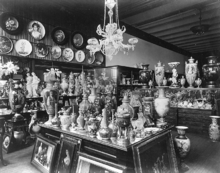
Founded in 1837 by Charles Lewis Tiffany and John B. Young[16] in Brooklyn, Connecticut, as a "stationery and fancy goods emporium", with the help of Charles Tiffany's father who financed the store for only $1,000 with profits from a cotton mill operated by slaves.[17][18] The store initially sold a wide variety of stationery items, and operated as "Tiffany, Young and Ellis" as of 1838 at 259 Broadway in Lower Manhattan.[19] The name was shortened to Tiffany & Company in 1853, when Charles Tiffany took control and established the firm's emphasis on jewelry.[20] The company has since opened stores in major cities worldwide. Unlike other stores at the time in the 1830s, Tiffany clearly marked the prices on its goods to forestall any haggling over prices. In addition, against the social norm at the time, Tiffany only accepted cash payments, and did not allow purchases on credit.[21] Such practices (fixed prices for ready money) were first introduced in 1750 by Palmer's of London Bridge.[22]
"Blue Book" and the Civil War
The first Tiffany mail order catalog, known as the "Blue Book", was published in 1845 in the United States (U.S.),[23] and publishing of the catalog continues in the 21st century. In 1862, Tiffany supplied the Union Army with swords (Model 1840 Cavalry Saber), flags and surgical implements. In 1867, Tiffany was the first U.S. firm to win an award for excellence in silverware at the Exposition Universelle in Paris. In 1868, Tiffany was incorporated.[11]
"Gilded Age"
In 1870, the company built a new store building at 15 Union Square West, Manhattan, designed by John Kellum and cost $500,000. It was described by The New York Times as a "palace of jewels".[24] Tiffany stayed at this site until 1906.[24]
In 1877, an insignia that would become the New York Yankees "NY" logo was struck on a police medal of honor by Tiffany; the Yankees adopted the logo in 1909. In 1878, Tiffany won the gold medal for jewelry and a grand prize for silverware at the Paris Exposition. In 1879, Tiffany purchased one of the world's largest yellow diamonds which became known as the Tiffany Diamond. The Tiffany Diamond was worn by only two people, one of which was Audrey Hepburn for the promotion of "Breakfast at Tiffany's".[17] In 1887, Tiffany bought the French Crown Jewels, which attracted publicity and further solidified the Tiffany brand's association with high-quality diamonds.[25] The company revised the Great Seal of the United States in 1885. In 1902, after the death of Charles Lewis Tiffany, his son, Louis Comfort Tiffany, became the company's first official design director.[23] In 1905, the Manhattan flagship store was relocated to a new location, at the corner of 37th Street and Fifth Avenue, where it would remain for 35 years.[26]
1900–1999
The company has not only sold the most brilliant diamonds but also introduced many previously unknown colored gems throughout history. In 1902, Tiffany unveiled kunzite, a purplish pink gem discovered in California, named after Tiffany's notable gemologist George Frederick Kunz. In 1910, the morganite was unearthed in Madagascar and was named after Tiffany's most loyal customer, banking tycoon John Pierpont Morgan. More discoveries came such as the tanzanite and the tsavorite.[27]
In 1919, the company made a revision to the Medal of Honor on behalf of the United States Department of the Navy.[28] This "Tiffany Cross" version was rare because it was awarded only for combat, using the previous design for non-combat awards.[29] In 1942, the Navy established the Tiffany version for non-combat heroism as well but, in August 1942, the Navy subsequently eliminated the Tiffany Cross and the two-medal system.[30]
In 1956, legendary designer Jean Schlumberger joined Tiffany, and Andy Warhol collaborated with the company to create Tiffany holiday cards (circa 1956–1962).[23][31] In 1968, Lady Bird Johnson, First Lady of the U.S. at the time, commissioned Tiffany to design a White House china-service that featured 90 flowers.[32][33]
In November 1978, Tiffany & Co. was sold to Avon Products Inc. for about US$104 million in stock. However, in a 1984 Newsweek article, the Fifth Avenue Tiffany store was likened to the Macy's department store during a white sale, due to the high number of inexpensive items on sale;[21] furthermore, customers complained about declining quality and service. In August 1984, Avon sold Tiffany to an investor group led by William R. Chaney for $135.5 million in cash. Tiffany went public again in 1987 and raised about $103.5 million from the sale of 4.5 million shares of common stock.[21]
Due to the 1990–1991 recession in the United States, Tiffany commenced an emphasis upon mass merchandising. A new campaign was launched that stressed how Tiffany could be affordable for all; for example, the company advertised that the price of diamond engagement rings started at $850. “How to Buy a Diamond” brochures were sent to 40,000 people, who called a toll-free number specifically set up to target the broader population.[21] However, to maintain its image as a luxury goods company, high-style images remained on display in Tiffany stores.[21]
Tiffany & Co. trademarked their signature turquoise brand color in 1998.[34]
2000s
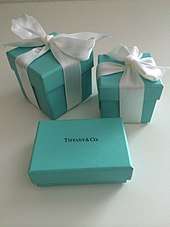
The Tiffany & Co. Foundation was established in 2000 to provide grants to nonprofit organizations working in the areas of the environment and the arts.[35] In June 2004, Tiffany sued eBay, claiming that the latter was making profits from the sale of counterfeit Tiffany products;[36] however, Tiffany lost both at trial and on appeal.[37]
In 2001, Tiffany & Co. partnered with Pantone to create "1837 Blue", inspired by the earlier Tiffany Blue shade.[34]
Tiffany & Co. established their subsidiary Laurelton Diamonds in 2002 to manage Tiffany's worldwide diamond supply chain.[38]
In 2009, a collaboration between the Japanese mobile-phone operator SoftBank and Tiffany & Co. was announced. The two companies designed a cellphone, limited to ten copies, and containing more than 400 diamonds, totaling more than 20 carats (4.0 g). Each cellphone cost more than 100 million yen (£781,824).[39]
Also in 2009, the company launched their Tiffany Keys collection.[40]
2010s
A media report in early July 2013 revealed that former Tiffany & Co. vice president Ingrid Lederhaas-Okun had been arrested and charged with stealing more than $1.3 million of diamond bracelets, drop earrings, and other jewelry. According to prosecutors from Manhattan, the official charges filed against Lederhaas-Okun accused her of "wire fraud and interstate transportation of stolen property."[41]
The company's Francesca Amfitheatrof-designed Tiffany T collection debuted in 2014.[42]
In February 2017, the company announced that CEO Frédéric Cuménal was out of a job, effective immediately, after only 22 months, blaming weak sales results. He was replaced on an interim basis by the company's longtime former CEO, Michael Kowalski.[43] Shortly before his abrupt departure, Cuménal had appointed former Coach designer Reed Krakoff as the company's new chief artistic officer. Although Krakoff had had no previous experience with jewellery design, his previous success with Coach and "deep understanding of iconic American design" led to his appointment, with the hopes that Krakoff would be able to refresh the image of the brand.[44][45]
In April 2017, the company launched their Tiffany HardWear collection.[46]
In July 2017, it was announced that Bulgari veteran Alessandro Bogliolo would be taking over as CEO. Under his leadership, it was hoped that Tiffany & Co. could turn around slumping sales and capture a younger audience.[47]
Tiffany & Co. opened the Blue Box Cafe in New York City in November 2017.[48] Also in November 2017, the company launched their Home & Accessories line.[49]
In March 2018, the company opened the Jewelry Design and Innovation Workshop, a new 17,000-square-foot atelier.[48]
In May 2018, Tiffany launched their Paper Flowers Collection, designed by Reed Krakoff.[50]
In September 2018, Tiffany launched their Paper Flowers collection in Asia.[51] That same month, the company debuted a new proprietary engagement ring design called the Tiffany True.[52]
In August 2019, Tiffany launched their first men's jewelry collection in October of the same year.[53] The line was developed by Reed Krakoff.[54]
In October 2019, Tiffany opened a new brand exhibition in Shanghai, China called "Vision & Virtuosity".[55] Later that month, the company removed an online advertisement after it was accused of portraying support for the 2019–20 Hong Kong protests and potentially jeopardizing its business in China.[56]
In November 2019, LVMH announced its purchase of Tiffany & Co for $16.2 billion, $135 per share.[14] The deal was expected to close by June 2020.[15]
Tiffany opened its first store in New Delhi, India on 3 February 2020.[57]
Stores
.jpg)
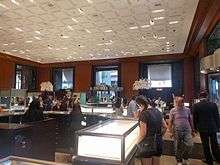
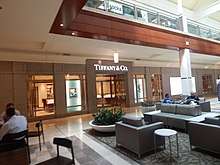
Since 1940, Tiffany's flagship store has operated at the corner of Fifth Avenue and 57th Street in Manhattan, New York City. The polished granite exterior is well known for its window displays, and the store has been the location for a number of films, including Breakfast at Tiffany's, starring Audrey Hepburn, and Sweet Home Alabama, starring Reese Witherspoon. The former Tiffany and Company Building on 37th Street is on the U.S. National Register of Historic Places.[58]
When it opened in 1990, the Tiffany & Co. store at Fairfax Square in Tysons Corner, Virginia, became the largest outside of New York City, with 14,500 sq ft (1,350 m2) of retail space.[59]
In France, Tiffany stores are located in Rue de la Paix and the Avenue des Champs Elysées (the largest European store[60]) in Paris, but also in the Galeries Lafayette and Printemps department stores, in Terminal 2 at Paris' Charles de Gaulle airport (two stores), and on the French Riviera in Nice.
In the United Kingdom (UK), Tiffany stores are located in Terminal 5, at London's Heathrow airport (opened at the end of March 2008), in the Westfield London shopping centre in Shepherd's Bush, in Old Bond Street, opposite the entrance to Burlington Gardens, and in Manchester, Selfridges Exchange Square. A flagship Irish store was opened in Brown Thomas on Dublin's Grafton Street in October 2008 and is the second largest of the company's European outlets. Also in October 2008, Tiffany's opened a store in Madrid, Spain, and brought the Tiffany Yellow Diamond (pictured at right) to the opening.
In Australia, Tiffany's flagship store is located on Collins Street in Melbourne, first established in 1996.[61] Other stores include Chadstone Shopping Centre (Melbourne); Sydney (Castlereagh Street, Westfield Bondi Junction and DFS Galleria on George Street); Brisbane (Queens Plaza); and Perth (King Street).
In Japan、Tiffany's flagship store is located in Ginza and opened in 2009. They also have a large store in Shinjuku (opened in 2014) and many other branches.
On March 8, 2001, Tiffany launched its first Latin American store in São Paulo, Brazil, located in the Iguatemi São Paulo shopping center.[62] The company opened a second store in the city on October 20, 2003,[63] near the famous Oscar Freire Street. The last store opened was Curitiba in September 2013, now Tiffany has stores in São Paulo, Rio de Janeiro, Brasília e Curitiba.
In 2004, Tiffany created "Iridesse", a chain of stores dedicated to pearl-only jewelry. The company operated 16 stores in Florida, New Jersey, New York, Pennsylvania, California, Illinois, Massachusetts, and Virginia. However, the chain operated at a loss since its founding and the company announced in early 2009 that, despite its continued belief in the concept, it would discontinue Iridesse due to the financial crisis of 2007-2008.[64]
Tiffany & Co. reported in 2006 that its location at South Coast Plaza in Costa Mesa, California, was its most profitable location, followed by the New York City flagship store, the Boston, Massachusetts outlet in Copley Place, and the Ala Moana Shopping Center in Honolulu, Hawaii.
Tiffany & Co. announced its second store opening at Pavilion Kuala Lumpur in Kuala Lumpur, Malaysia in September 2007 to coincide with the shopping mall's opening. The store consists of 1,700 sq ft (160 m2) retail space and features the same decor elements as the New York City flagship store. Later that year, other stores were opened in the U.S., such as the Natick Collection in Natick, Massachusetts, which opened in September 2007, Mohegan Sun Erika's casino in Connecticut, and the Providence Place mall in Providence, Rhode Island, both of which opened in November 2007.
As of January 31, 2007, the company operated 64 Tiffany & Co. stores in the U.S., with a total physical area of approximately 486,000 gross square feet, as well as 103 international stores that measure approximately 306,000 gross square feet in total.
The company's expansion continued in 2011 with the opening of a store at the Multiplaza complex in Escazú, Costa Rica, and a Richmond, Virginia, location in Stony Point Fashion Park on September 9, 2011.
In November 2012, the company operated in 22 countries, and its worldwide net sales reached $3.6 billion in 2011. Over 50% of the company's 2011 sales occurred in the U.S.[65]
As of January 31, 2014, the company operated 121 stores in the Americas, 72 in the Asia-Pacific region, 54 in Japan, 37 in Europe and 5 in "emerging markets". The 298[66] stores have 1,165,700 gross retail square footage. The company's flagship store in New York had 45,500 gross retail square footage and accounted for 8% of the company's net sales in the fiscal year ended January 31, 2014. The company planned to continue expanding in 2014 with the opening of a flagship store at the Centro Andino complex in Bogota, Colombia.
As of 2018, Tiffany operated 93 stores in the US and 321 stores worldwide, including (as of 31 January 2017) 55 locations in Japan and 85 in the Asia-Pacific region. Net sales in 2018 totaled US$4.44 billion.[67][13]
Manufacturing
The company's manufacturing facilities produce approximately 60% of the merchandise sold —the balance, including rose-gold and almost all non-jewelry items, coming from third parties overseas. Tiffany's oversees a significant U.S. manufacturing base, with jewelry and silver goods produced in Mount Vernon, New York; majority in Cumberland, Rhode Island; and Lexington, Kentucky, while silver hollow-ware is produced in Rhode Island. The company's other subsidiaries, located in facilities outside the U.S., process, cut and polish the diamonds.
The company may increase the percentage of internally manufactured jewelry in the future, but it is not expected that Tiffany will ever manufacture all of its needs. Some of the key factors which management considered prior to its decision to outsource manufacturing included: product quality; gross margin; access to or mastery of various jewelry-making skills and technology; support for alternative capacity; and the cost of capital investments.[68]
Advertising
After the initial publication of the "Blue Book" Tiffany catalog in 1845, Tiffany continued to use its catalog as part of its advertisement strategy. The Tiffany catalog, one of the first catalogs printed in full color, remained free until 1972. Tiffany's mail-order catalogs reached 15 million people in 1994. Tiffany also produces a corporate-gift catalog each year, and corporate customers purchase Tiffany products for business gift-giving, employee-service and achievement-recognition awards, and for customer incentives. Tiffany still produces a catalog for subscribers, but its advertisement strategy no longer focuses primarily on its catalog.[11]
In addition to the mail-order catalog, Tiffany displays its advertisements in many locations, including at bus stops, in magazines and newspapers, and online. Tiffany routinely places ads in Vanity Fair, The New York Times Magazine, Architectural Digest, Money, Conde Nast Traveler, Black Enterprise, and Texas Monthly. With the advent of new technologies, Tiffany places banner advertisements in the New York Times' mobile app for the iPhone, whereby the user can download the Tiffany app free of charge.[69][70] In January 2015, they launched their first ever same-sex couple campaign.
In 2017, Tiffany partnered with American pop star Lady Gaga for an ad campaign promoting the company's HardWear collection.[71] The announcement came as a Super Bowl ad prior to Lady Gaga's Super Bowl LI halftime show performance.[72]
In May 2018, Tiffany partnered with Spotify for the launch of Tiffany's "Believe in Dreams" campaign and Paper Flowers collection, releasing a cover of the song "Moon River" by Elle Fanning and rapper A$AP Ferg on the music streaming service.[73]
In 2019, Tiffany partnered with American celebrity Kendall Jenner to promote the company's spring fashion line.[74]
Products
Diamonds
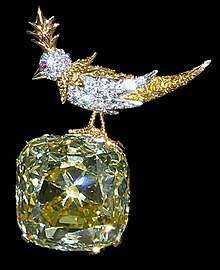
George Frederick Kunz (1856-1932), a Tiffany's gemologist, became instrumental in the international adoption of the metric carat as a weight standard for gems, and the Tiffany standards for sterling and platinum have been adopted as U.S. standards. The Tiffany Yellow Diamond (128.54 carats (25.708 g)) is usually on display in the New York City flagship store.[75]
In 1886, founder Charles Tiffany conceived of the Tiffany Setting ring design, in which six prongs hold the diamond off of the band, in order to better accentuate the diamond.[76]
Famous U.S. families such as the Astors, Vanderbilts, Posts, Huttons and Morgans have worn Tiffany designs.[77] Athletes, Hollywood stars, and European royalty also became Tiffany customers. However, like other similar diamond retailers, Tiffany's enacts a strict policy against the repurchasing of diamonds sold from its stores. In 1978, a female customer in New York City was denied after she attempted to sell back a diamond ring she had bought from Tiffany two years earlier for $100,000. Writing for The Atlantic publication in 1982, Edward Jay Epstein explained the rationale for such a policy:
Retail jewelers, especially the prestigious Fifth Avenue stores, prefer not to buy back diamonds from customers, because the offer they would make would most likely be considered ridiculously low ... Most jewelers would prefer not to make a customer an offer that might be deemed insulting and also might undercut the widely held notion that diamonds go up in value. Moreover, since retailers generally receive their diamonds for engagement rings from wholesalers on consignment, and need not pay for them until they are sold, they would not readily risk their own cash to buy diamonds from customers. Rather than offer customers a fraction of what they paid for diamonds, retail jewelers almost invariably recommend to their clients firms that specialize in buying diamonds "retail."[78]
In 2019, Tiffany CEO Alessandro Bogliolo announced that in 2020 the company would become transparent regarding the country or region of origin of the company's newly sourced and individually registered diamonds.[79]
Colored gemstones
Tiffany offers jewelry incorporating a wide variety of colored gemstones including gems it played a role in popularizing such as tsavorite,[80] Kunzite, and morganite. In February 2015, a turquoise and aquamarine bib designed by Francesca Amfitheatrof, Tiffany's design director, worn by Cate Blanchett at the 2015 Academy Awards, contrasted favorably with the white–diamond encrusted jewelry worn by other stars.[66]
Fragrances
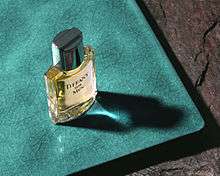
In the late 1980s, Tiffany & Co. ventured into the fragrance business. "Tiffany" for women was launched in 1987, a floral perfume for women by perfumer Francois Demachy. At $220 per ounce, "Tiffany" was successfully marketed by major department stores across the United States.[81] Two years later, "Tiffany for Men" was launched in 1989 and developed by perfumer Jacques Polge. The bottles for both the men's and women's fragrance were designed by Pierre Dinand.[82] In 1995, Tiffany launched "Trueste" perfume for women, which was later discontinued. Currently, Tiffany continues to produce the core fragrance product for men and the product for women.
In October 2019, Tiffany launched a new fragrance line, Tiffany & Love.[83]
Sports awards
Tiffany & Co is the maker of the Vince Lombardi Trophy, made for the winner of the NFL team that wins the Super Bowl that year.[84][85] Since 1977, Tiffany & Co. has manufactured Larry O' Brien Trophy, the trophy that is given to the winner of the NBA Finals.[84]
Tiffany makes and designed the Commissioner's Trophy trophy each year, given to the winner of the World Series.[84] Tiffany & Co made the 2010 and 2012 World Series rings for the San Francisco Giants.[86]
Since 1987, Tiffany silversmiths have crafted the US Open trophies for the United States Tennis Association.[84]
Tiffany & Co makes the PGA Tour FedEx Cup Trophy each year since 2007.[84]
The MLS championship trophy was made by Tiffany & Co.[87]
The NASCAR Sprint Cup Series' Sprint Cup trophy is made by Tiffany & Co, and is given to the champion every year.
The Detroit Gold Cup trophy made originally by Tiffany & Co in 1904, is awarded annually to the champion of the Detroit Gold Cup H1 Unlimited hydroplane race.
A £10,000 Rugby League World Cup trophy was made by Tiffany's to celebrate the centenary of Rugby league.[88]
Current designers and collections
- Elsa Peretti's collections include Bean, Diamonds by the Yard, Open Heart, Sevillana, and Teardrop
- Paloma Picasso's collections include Loving Heart and Sugar Stacks
- Jean Schlumberger
Philanthropy
In 2000, The Tiffany & Co. Foundation awarded its first grant to support coral and marine conservation. To date, the foundation has awarded over $20 million in grant money to coral and marine conservation causes.[89]
In 2008, The Tiffany & Co. Foundation donated $2 million to the University of Pennsylvania for the construction of an HIV/AIDS treatment facility in Botswana.[90]
In 2010, Tiffany awarded a $1 million grant to the Trust for Public Land and its campaign to save Cahuenga Peak.[91]
Tiffany launched their Save the Wild Collection in 2017, a line at promoting endangered wildlife conservation.[92] Save the Wild debuted as part of the #KnotOnMyPlanet wildlife conservation campaign.[93] In 2018, Tiffany announced a commitment of approximately $1.4 million to Australia for efforts to protect and conserve the Great Barrier Reef.[94]
Corporate sustainability efforts
Tiffany has bought ethically mined gold since 1992. The company also abides by the Kimberly certification process when sourcing diamonds.[95]
Due to coral became endangered, thus threatening oceanic health and sustainability, Tiffany discontinued sales of coral jewelry in 2004 to improve responsible sourcing practices.[89] In 2005, Tiffany joined Earthwork's No Dirty Gold campaign, becoming the first jewelry company to apply the Earthwork's Golden Rules for responsible mining.[96]
In 2006, Tiffany & Co. joined Microsoft, IdustriALL Global Union, United Steelworkers along with others in founding the Initiative for Responsible Mining Assurance, known as IRMA.[97]
In 2011, Tiffany joined the United Nations Global Compact initiative in efforts to align company operations with the Compact's global sustainability goals, including human rights, labor, environment, and anti-corruption.[95]
In 2015, Anisa Costa was appointed Tiffany's first-ever Chief Sustainability Officer.[98][99] That same year, Tiffany joined a number of fellow corporations in pledging to reach net-zero greenhouse gas emissions by 2050. The company also advocated for the U.S. to remain in the Paris Agreement along with other companies as part of the "We are still in" social media campaign.[100]
In popular culture
The retailer has been mentioned in various works, most notably in the title of the 1958 Truman Capote novella Breakfast at Tiffany's, adapted as a 1961 film of the same name starring Audrey Hepburn, which in turn prompted a 1966 musical flop. The Hepburn film was later invoked in the refrain of a 1995 alternative rock song. In the 1974 song "Hotel California" by the Eagles there is a line: "Her mind is Tiffany-twisted" which describes a woman in love with power and money. In the fifth season of The Office (U.S.), Dwight Schrute mentions the store when he is describing his perfect crime. The heroine of the James Bond 1956 novel and 1971 film Diamonds Are Forever is named Tiffany Case, allegedly because her mother gave birth to her there.[101]
In the 1987 Stanley Kubrick film Full Metal Jacket, the character "Gunnery Sergeant Hartmann", played by R. Lee Ermey reprimands "Private Leonard "Gomer Pyle" Lawrence", played by Vincent D'Onofrio, for grinning. Sergeant Hartman, after physically discplining Lawrence, says: "Private Pyle, you had best square your ass away and start shitting me Tiffany cufflinks, or I will definitely fuck you up." Hartman is essentially saying that Lawrence must rectify his behavior to a point where everyone of his actions are perfect.
Gallery
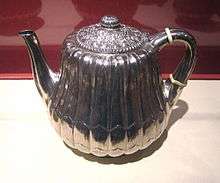 Silver tea pot
Silver tea pot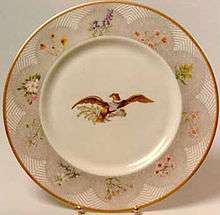 White House china service for Lady Bird Johnson
White House china service for Lady Bird Johnson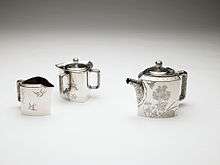 Tea set, c. 1877, held at the Birmingham Museum of Art
Tea set, c. 1877, held at the Birmingham Museum of Art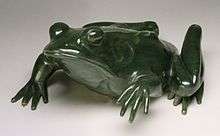 Carved frog for display at the Exposition Universelle (1900) in Paris
Carved frog for display at the Exposition Universelle (1900) in Paris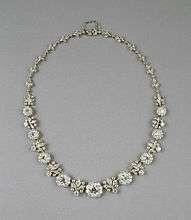 Diamond necklace, c. 1904
Diamond necklace, c. 1904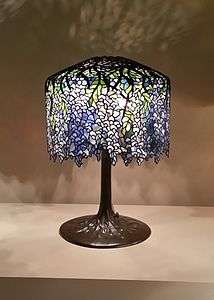 Wisteria Tiffany Studios lamp, c. 1902
Wisteria Tiffany Studios lamp, c. 1902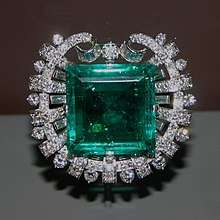 Hooker Emerald Brooch, commissioned by Tiffany in 1950
Hooker Emerald Brooch, commissioned by Tiffany in 1950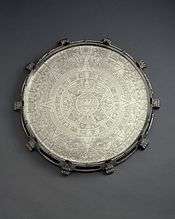 Tray or Waiter, displayed at World's Columbian Exposition, 1893, Brooklyn Museum
Tray or Waiter, displayed at World's Columbian Exposition, 1893, Brooklyn Museum
See also
- Art Nouveau glass art
- Yeojin Bae
- Clara Driscoll (Tiffany glass designer)
- Walter Hoving
- John Loring (designer)
- Camille Le Tallec
- Tiffany glass
Notes
- O'Connell, Liam (March 27, 2020). "Tiffany & Co.'s number of retail locations worldwide in 2019, by region". Statista. Statista. Retrieved May 7, 2020.
- "Tiffany & Co. (TIF) NYSE - Nasdaq Real Time Price. Currency in USD". Yahoo. Yahoo. May 19, 2020. Retrieved May 19, 2020.
- "Tiffany company profile". Craft. Retrieved August 9, 2019.
- "US SEC: Form 10-K Tiffany & Co". U.S. Securities and Exchange Commission. Retrieved February 22, 2018.
- "Tiffany & Co". New York Times. Retrieved January 20, 2016.
- Cohen, Patricia. "Tiffany_and_co". The New York Times.
- Agrawal, A. J. "How Tiffany & Co. Built A Marketing Empire". Forbes. Retrieved March 24, 2019.
- King, Steve (November 18, 2016). "Tiffany & Co: leading the way in ethically produced jewellery". The Telegraph. ISSN 0307-1235. Retrieved March 24, 2019.
- "Tiffany's 'old-world luxury' fails to charm millennials". Reuters. May 26, 2016. Retrieved March 24, 2019.
- "The Anglo Effect: U.S. and British Luxury Brands Gain Ground With China's Rich". Jing Daily. February 16, 2015. Retrieved February 4, 2020.
"Tiffany & Co. is now the no. 1 American luxury brand for Chinese shoppers". Jing Daily. February 17, 2015. Retrieved March 24, 2019 – via Business Insider. - "History of Tiffany & Company – FundingUniverse". Fundinguniverse.com. Retrieved February 18, 2013.
- "Tiffany & Co". Bloomberg. July 11, 2019. Retrieved November 30, 2019.
and also engages in direct selling through internet, catalog, and business gift operations
- "Number of Tiffany & Co. stores by region worldwide in 2018, by region". Statista. August 9, 2019. Retrieved November 30, 2019.
- Kent, Sarah; Guilbault, Laure (November 25, 2019). "LVMH Buys Tiffany in $16 Billion Deal". www.businessoffashion.com. Retrieved November 25, 2019.
- "LVMH Acquires Tiffany & Co. For $16.2 Billion". Forbes. November 26, 2019. Retrieved November 30, 2019.
LVMH will "develop this jewel with the same dedication and commitment that we have applied to each and every one of our Maisons. We will be proud to have Tiffany sit alongside our iconic brands and look forward to ensuring that Tiffany continues to thrive for centuries to come"
- "Tiffany & Co. For The Press | About Tiffany & Co. | Tiffany & Co. History | United States". Press.tiffany.com. Retrieved August 1, 2015.
- Tiffany, How; September 5, Co Is Bringing Breakfast To Its Reimagined Retail Experience | APAC Newswire; 2018 11:28at11:28am (October 19, 2016). "The Beginning of a Brand: Tiffany & Co. | The Loupe, TrueFacet". Retrieved March 18, 2020.
- World, Your Black. "Shocking List of 10 Companies that Profited from the Slave Trade". Race, Racism and the Law. Retrieved June 28, 2020.
- The Albion. March 24, 1838. p. 95. Missing or empty
|title=(help) - "CUSHION CUT Archives". Awegirls. Retrieved August 1, 2015.
- "History of Tiffany & Company – FundingUniverse". Fundinguniverse.com. Retrieved February 18, 2013.
- R. J. Mitchell and M. D. R. Leys (1958). A History of London Life. London, England: Longmans, Green and Co. pp. 182–4.
- "Tiffany & Company | The Tiffany Story | United States". Tiffany.com. Retrieved February 18, 2013.
- Christopher Gray (July 2, 2006). "Before Tiffany & Co. Moved Uptown". The New York Times. Retrieved September 25, 2013.
- "Tiffany & Company | A Tiffany Diamond | Our Promise | Tiffany Diamond Certificate | United States". Tiffany.com. Retrieved February 18, 2013.
- Gray, Christopher (July 2, 2006). "Before Tiffany & Co. Moved Uptown". The New York Times. Retrieved May 7, 2020.
- "The history of Tiffany". www.thejewelleryeditor.com. June 17, 2016. Retrieved March 18, 2020.
- Birnie, Michael (April 27, 2003). ""Tiffany" Medal of Honor Comes to Navy Museum". U.S. Navy Museum. United States Navy. Archived from the original on September 6, 2009. Retrieved February 15, 2010.
- Tillman, Barrett (2003). Above and Beyond: The Aviation Medals of Honor. Washington, D.C.: Smithsonian Institution Press. p. 3.
- "History of the Medal of Honor". Navy Medal of Honor (1913). Congressional Medal of Honor Society. Retrieved July 23, 2010.
- "Image not available". Corbisimages.com. Retrieved February 18, 2013.
- "Presidential China". The White House. Archived from the original on January 18, 2009. Retrieved December 7, 2008.
- "Party Politics" Entertaining at the White House" (PDF). National First Ladies Library. Retrieved December 7, 2008.
- Cohen, Alina (April 30, 2019). "How Tiffany & Co. monopolized a shade of blue". CNN. CNN. Retrieved May 4, 2020.
- "The Tiffany & Co. Foundation | About the Foundation". Tiffanyandcofoundation.org. Retrieved February 18, 2013.
- "Tiffany sues eBay, says fake items sold on Web site". USA Today. March 22, 2004.
- "Tiffany, Inc. v. eBay" (PDF). April 1, 2010.
- O'Connell, Vanessa (October 26, 2009). "Diamond Industry Makeover Sends Fifth Avenue to Africa". Wall Street Journal. Wall Street Journal. Retrieved May 4, 2020.
- 上戸彩:超高価ケータイ「ないしょにしてね」 (in Japanese). Sports Nippon. Archived from the original on January 30, 2008. Retrieved January 29, 2008.
- Skinner, Poppy (September 3, 2015). "The Tiffany Key Collection". Singapore Tatler. Singapore Tatler. Retrieved May 4, 2020.
- Chad Bray (July 4, 2013). "Tiffany executive gem theft charges". The Australian. Retrieved July 4, 2013.
- Rutherford, Chrissy (November 7, 2014). "Tiffany & Co. Takes Us for a Ride on the T Train". Harpers Bazaar. Harpers Bazaar. Retrieved May 4, 2020.
- "Tiffany CEO Out After Less Than 2 Years Because of Poor Sales". Fortune. Retrieved February 6, 2017.
- "Tiffany Appoints Reed Krakoff as Chief Artistic Officer". The Business of Fashion. January 17, 2017. Retrieved September 28, 2019.
- "Can the Man Who Made Coach Remake Tiffany?". The Business of Fashion. May 1, 2018. Retrieved September 28, 2019.
- Halberg, Morgan (April 28, 2017). "Zoë Kravitz, Scarlett Johansson Are Really Into Tiffany's New Collection". Observer. Observer. Retrieved May 5, 2020.
- "Subscribe to read". Financial Times. Retrieved September 28, 2019.
- Binkley, Christina (March 26, 2018). "The Secret Inside Tiffany's Blue Box: Reed Krakoff". Wall Street Journal. Wall Street Journal. Retrieved May 5, 2020.
- Roberts, Embry (November 4, 2017). "Tiffany & Co. launched an outrageously indulgent home and accessories line". Today. Today. Retrieved May 5, 2020.
- Friedlander, Ruthie (May 1, 2018). "Tiffany & Co. Unveils a New Collection That Strips Away the Typical Rules of Fine Jewelry". InStyle. InStyle. Retrieved May 4, 2020.
- Soo-jin, Kim (September 14, 2018). "Tiffany launches Paper Flowers collection with a star-studded party in Shanghai". SCMP. SCMP. Retrieved May 4, 2020.
- Chen, Joyce (September 19, 2018). "Tiffany & Co. Debuts New Engagement Design Called the "Tiffany True" Diamond". The Knot. The Knot. Retrieved May 5, 2020.
- Siegel, Rachel (August 15, 2019). "Tiffany & Co. launches men's line, hoping diamonds are a dude's best friend". Washington Post. Washington Post. Retrieved May 4, 2020.
- Remsen, Nick (September 15, 2019). "Tiffany Creates Another Reason for Men to Shop". The New York Times. The New York Times. Retrieved May 4, 2020.
- Connor, Katie (November 3, 2019). "Tiffany's Vision & Virtuosity Exhibition Offers A Glittering Escape From Reality". Elle. Elle. Retrieved May 5, 2020.
- "Tiffany removes advert over Hong Kong controversy". Hong Kong Free Press. Agence France-Presse. October 8, 2019. Retrieved October 8, 2019.
- "Tiffany opens first India store in New Delhi - ET Retail". ETRetail.com. Retrieved February 13, 2020.
- Holly Hayes (June 2, 1978). "Tiffany and Company Building - New York, New York". Gohistoric.com. Retrieved August 1, 2015.
- Potts, M. (1989) "The Swanky Side of Fairfax Square" Washington Post
- "Le joaillier américain Tiffany arrive sur les Champs-Elysées". Le Monde.fr (in French). November 5, 2012. ISSN 1950-6244. Retrieved November 26, 2017.
- "Tiffany is out of the box". www.heraldsun.com.au. August 23, 2011. Retrieved July 14, 2019.
- "Tiffany abre em SP primeira filial na América Latina" (in Portuguese). Estadão. Retrieved July 26, 2010.
- "Quem entra na Tiffany acaba se apaixonando" (in Portuguese). Terra. Retrieved July 26, 2010.
- Cheng, Andria (March 10, 2009). "Tiffany plans to shut Iridesse pearl-jewelry chain". Marketwatch.
- "Russian diamonds to give new sparkle to Tiffany jewelry". RT.com. Autonomous Nonprofit Organization “TV-Novosti”. November 28, 2012. Retrieved July 15, 2013.
- Guy Trebay (April 14, 2015). "At Tiffany, Something New Inside the Blue Box". The New York Times. Retrieved April 16, 2015.
the scene-stealing bib had the commercially desirable effect of making the million-dollar gems on other entertainers look like so much borrowed ice.
- "Tiffany & Co.TIF". Reuters. November 29, 2019. Retrieved November 30, 2019.
the Company's segments include Americas, Asia-Pacific, Japan, Europe and Other
- "Edgar Pro". Yahoo.brand.edgar-online.com. Retrieved February 18, 2013.
- "Tiffany & Company continues app push with banner ads - Luxury Daily - Mobile". Luxury Daily. August 1, 2011. Retrieved February 18, 2013.
- "Tiffany & Co. Engagement Ring Finder for iPhone, iPod touch, and iPad on the iTunes App Store". Itunes.apple.com. October 22, 2011. Retrieved February 18, 2013.
- Adducci, Shannon (April 6, 2017). "Lady Gaga's Ad Campaign for Tiffany & Co. is Out Now". Billboard. Billboard. Retrieved May 1, 2020.
- Remsen, Nick (September 15, 2019). "Tiffany Creates Another Reason for Men to Shop". The New York Times. The New York Times. Retrieved May 1, 2020.
- Hargrove, Channing (May 3, 2018). "Elle Fanning & A$AP Ferg Remix Breakfast At Tiffany's "Moon River"". Refinery29. Refinery29. Retrieved May 1, 2020.
- Birmingham, Kirsten (April 17, 2019). "A Behind-the-Scenes Look at Kendall Jenner's Stunning Spring 2019 Tiffany & Co. Campaign". US Magazine. US Magazine. Retrieved May 1, 2020.
- "Breakfast at Tiffany's in Beverly Hills". Retrieved February 9, 2014.
- Pantin, Laurel (December 16, 2019). "The Reason Most Engagement Rings Look the Way They Do". InStyle. InStyle. Retrieved May 7, 2019.
- "History of Tiffany & Co: The Most Famous Jewelry Store". Bellatory. Retrieved March 18, 2020.
- Edward Jay Epstein (February 1, 1982). "Have You Ever Tried to Sell a Diamond?". The Atlantic. Retrieved July 15, 2013.
- Bhasin, Kim; Chandra, Emma (January 9, 2019). "Tiffany CEO Says It's His 'Duty' to Reveal Diamonds' Provenance". Bloomberg. Bloomberg. Retrieved May 7, 2020.
- "Tsavorite Garnet". Gemstone.org. Archived from the original on June 10, 2008. Retrieved August 1, 2015.
- "Tiffany & Co. Company History". Funding Universe. Retrieved February 18, 2013.
- Wells, Linda (July 12, 1987). "BEAUTY; A NEW SMELL FOR SUCCESS". The New York Times. ISSN 0362-4331. Retrieved October 1, 2017.
- Shatzman, Celia (October 1, 2019). "Tiffany & Co. Uses Groundbreaking Technology To Create A New Note For Its Latest Fragrance". Forbes. Forbes. Retrieved May 7, 2020.
- "Tiffany Trophies by the Numbers". Retrieved February 4, 2020.
- "Super Bowl Trophy". ixgames. September 18, 2008.
- "Giants get Tiffany World Series rings". Associated Press. April 10, 2011.
- "MLS Cup trophy tour launches this week in Houston | MLSsoccer.com". Retrieved October 28, 2019.
- "A history of the Rugby League World Cup". St Helens Star. October 1, 2013. Retrieved January 4, 2014.
- Hyland, Veronique (August 30, 2019). "Tiffany & Co. Is Working To Save Coral Reefs In Mauritius". Elle. Elle. Retrieved May 5, 2020.
- McWilliams, Julie; Buckley, Linda (October 16, 2008). "The Tiffany & Co. Foundation Gives $2 Million to Penn for HIV/AIDS Treatment Center in Botswana". Penn Today. Penn University. Retrieved May 4, 2020.
- "Hugh Hefner Honored for $1 Million Hollywood Sign Contribution". THR. THR. September 30, 2011. Retrieved May 4, 2020.
- Park, Andrea (March 7, 2019). "Good Company: Tiffany & Co.'s Save the Wild Collection". Barrons. Barrons. Retrieved May 4, 2020.
- Akel, Joseph (July 24, 2019). "Game Changers: How Tiffany & Co and KnotOnMyPlanet Are Trying to Save the Elephants". L'Officiel. L'Officiel. Retrieved May 4, 2020.
- Truman, Isabelle (July 26, 2018). "Tiffany & Co. Is Campaigning To Save The Great Barrier Reef". Marie Claire. Marie Claire. Retrieved May 4, 2020.
- Vijayaraghavan, Akhila (November 16, 2011). "Tiffany & Co Launches Sustainability Website". Triple Pundit. Triple Pundit. Retrieved May 5, 2020.
- Semeuls, Alana (February 14, 2007). "Jewelry companies look for values in valuables". LA Times. LA Times. Retrieved May 5, 2020.
- "BMW backs responsible mining". Mining Magazine. Mining Magazine. January 10, 2020. Retrieved May 4, 2020.
- Faulkner, Noelle (March 11, 2018). "Anisa Kamadoli Costa, chief sustainability officer at Tiffany & Co". Vogue. Vogue. Retrieved May 4, 2020.
- "Anisa Kamadoli Costa Bloomberg profile". Bloomberg. Bloomberg. Retrieved May 4, 2020.
- Stephanie, Chan (May 9, 2017). "Tiffany & Co. Sends Message About Climate Change to Donald Trump". THR. THR. Retrieved May 4, 2020.
- "Quotes (Diamonds Are Forever)". MI6.co.uk. Archived from the original on March 4, 2006. Retrieved November 4, 2019.
Tiffany: "I was born there, on the first floor while my mother was looking for a wedding ring."
References
- Bezdek, Richard H. American Swords and Sword Makers. Boulder, Colorado: Paladin Press, 1999.
- Bizot, Chantal, Marie-Noël de Gary, and Évelyne Possémé. The Jewels of Jean Schlumberger. New York: Harry N. Abrams, Publisher, 2001. (English translation)
- Carpenter, Charles and Janet Zapata. The Silver of Tiffany & Company, 1850–1987. Boston: Museum of Fine Arts, 1987.
- Dietz, Ulysses Grant, Jenna Weissman Joselit, and Kevin J. Smead. The Glitter and the Gold: Fashioning America’s Jewelry. Newark: The National Endowment for the Humanities, 1997.
- Duncan, Alastair, Martin Eidelberg, and Neil Harris. Masterworks of Louis Comfort Tiffany. New York: Harry N. Abrams, Inc., Publishers, 1989. Catalogue for an exhibition at the Renwick Gallery, Washington, D.C., from September 29, 1989 – March 4, 1990 and at the National Academy of Design, New York, from March 27 – July 8, 1990.
- Fashion Institute of Technology. Elsa Peretti: Fifteen of My Fifty with Tiffany. New York: Fashion Institute of Technology, 1990. Exhibition catalogue, April 24 – May 10, 1990.
- Frelinghuysen, Alice Cooney. Louis Comfort Tiffany and Laurelton Hall. New Haven, Connecticut: Yale University Press, 2006.
- Green, Annette and Linda Dyett. Secrets of Aromatic Jewelry. Paris: Flammarion, 1998.
- Hood, William P., with Roslyn Berlin and Edward Wawrynek. Tiffany Silver Flatware 1845–1905: When Dining was an Art. Suffolk, England: Antique Collectors Club, 1999.
- Loring, John. Tiffany Colored Gems. New York: Abrams, 2007. (Available Fall 2007)
- Loring, John. Greetings from Andy Warhol: Christmas at Tiffany's. New York: Abrams, 2004.
- Loring, John. Louis Comfort Tiffany at Tiffany & Co. New York: Abrams, 2002.
- Loring, John. Magnificent Tiffany Silver. New York: Abrams, 2001.
- Loring, John. The New Tiffany Tablesettings. New York: Doubleday, 1981.
- Loring, John. Paulding Farnham: Tiffany's Lost Genius. New York: Abrams, 2000.
- Loring, John. A Tiffany Christmas. New York: Doubleday, 1996.
- Loring, John. Tiffany Diamonds. New York: Abrams, 2005.
- Loring, John. Tiffany in Fashion. New York: Abrams, 2003.
- Loring, John. Tiffany Flora and Fauna. New York: Abrams, 2003.
- Loring, John. The Tiffany Gourmet Cookbook. New York: Doubleday, 1992.
- Loring, John. Tiffany Jewels. New York: Abrams, 1999.
- Loring, John. Tiffany's 150 Years. New York: Doubleday, 1987.
- Loring, John. Tiffany's Palm Beach. New York: Abrams, 2005.
- Loring, John. Tiffany Parties. New York: Doubleday, 1989.
- Loring, John. Tiffany Pearls. New York: Abrams, 2006.
- Loring, John. Tiffany Taste. New York: Doubleday, 1986.
- Loring, John. Tiffany Timepieces. New York: Abrams, 2004.
- Loring, John. Tiffany's 20th Century: A Portrait of American Style. New York: Abrams, 1997.
- Loring, John. The Tiffany Wedding. New York: Doubleday, 1988.
- Newman, Harold. An Illustrated Dictionary of Jewelry. London: Thames and Hudson, 1981.
- Phillips, Clare. Bejewelled by Tiffany: 1837–1987. New Haven and London: Yale University Press, 2006.
- Proddow, Penny and Debra Healy. American Jewelry, Glamour & Tradition. New York: Rizzoli, 1987.
- Proddow, Penny and Debra Healy. Diamonds: A Century of Spectacular Jewels. New York: Abrams, 1996.
- Purtell, Joseph. The Tiffany Touch. New York: Random House, 1971.
- Ricci, Franco Maria. Jean Schlumberger. Milan: Franco Maria Ricci, 1991.
- Schnierla, Peter and Penny Proddow. Tiffany: 150 Years of Gems and Jewelry. New York: Tiffany & Co., 1987.
- Snowman, Kenneth A. The Master Jewelers. New York: Abrams, 1990.
- Stern, Jewel. Modernism in American Silver. New Haven: Yale University Press, 2005.
- Tiffany Retrospective: Designs from Tiffany and Co., 1837–1999. Tokyo and New York: APT, 1999.
- Un Diamant Dans La Ville: Jean Schlumberger 1907–1987 Bijoux - Objets. Paris: Musee des Arts decoratifs: 1995.
- Venable, Charles L. Silver in America 1840–1940: A Century of Splendor. Dallas, Texas: Dallas Museum of Art, 1994.
- Warren, David B. et al. Marks of Achievement: Four Centuries of American Presentation Silver. Houston: Museum of Fine Arts, in association with Harry N. Abrams, Inc., 1987.
- Zapata, Janet. The Jewelry and Enamels of Louis Comfort Tiffany. New York: Harry N. Abrams, Publishers, 1993*.
